Vintage Wedgwood Jasperware Jewelry
Recent Sales
Vintage 1970s English Retro Stud Earrings
Gold, 9k Gold, Yellow Gold
Wedgwood for sale on 1stDibs
Arguably the most celebrated of all English ceramics makers, Wedgwood was founded in 1759 by potter Josiah Wedgwood (1730–95) in Staffordshire, which was home at one time to hundreds of pottery workshops. The company is famed for its Jasperware — molded neoclassical stoneware vases, plates and other pieces inspired by ancient cameo glass, featuring white figures, scenes and decorative elements set in relief on a matte-colored background. The best-known background hue is light blue, but Wedgwood’s iconic silhouettes also appear on green, lilac, yellow, black and even white grounds. Some antique Wedgwood dinnerware pieces and other items feature three or more colors.
The Wedgwood firm first came to prominence for its tableware, which quickly gained favor in aristocratic households throughout Britain and Europe. In 1765, Wedgwood was commissioned to create a cream-colored earthenware service for Queen Charlotte, consort of King George III. The queen was so thrilled with her new china that Wedgwood was given permission to call himself “Potter to Her Majesty,” and the decorative style became known as Queen’s Ware.
Not to be outdone, Catherine the Great of Russia commissioned her own set of Wedgwood china in 1773. Nearly 200 years later, the firm created a 1,200-piece service for the coronation of Queen Elizabeth II. In recent years, leading designers including Jasper Conran and Vera Wang have collaborated with Wedgwood — in the tradition of such distinguished 18th-century artists such as the painter George Stubbs and metalsmith Matthew Boulton.
From plates and other dinnerware to decorative items like urns, cachepots and candlesticks, Wedgwood designs lend a traditional air to Anglophile interiors. And even if you have to make your own tea, you may find it comforting to sip it from a delicate cup that was manufactured in the same Stoke-on-Trent kiln that produced Her Majesty’s tea service. Be sure to keep your pinky raised.
Find antique Wedgwood pottery on 1stDibs.
Finding the Right stud-earrings for You
Stud earrings have a unique and rich cultural history. Though their design has evolved, vintage stud earrings are still a classic jewelry style.
Stud earrings are frequently dated back over 7,000 years to Asia, where they were worn mostly by upper-class men to indicate their wealth and status. Although earrings sometimes fell out of favor over the years — such as when ear piercing was prohibited by the Catholic Church in the 13th century — they’ve remained one of the most enduring forms of body modification.
When diamond jewelry gained prominence in the 19th century, thanks to prosperity in Europe and the United States as well as the greater accessibility of gemstones, studs adorned with fine diamonds became popular. Screw-back earrings debuted in the late 19th century and allowed people without pierced ears to don the embellishment. Stud earrings became especially popular in the 1960s.
Stud earrings are simple and usually small in size, making them lightweight and easy to wear. Unlike other earrings, stud earrings have a floating appearance. They are often made with a single gemstone, such as a sapphire or emerald, and a straight post that goes through the ear, typically with a rubber or metal backing to hold it in place.
Today, stud earrings accentuate outfits with a casual, elegant style, adding a bit of glam to any ensemble. Find an eclectic array of stud earrings on 1stDibs.
